Ruta de navegación
Menú de navegación
Blogs
Entries with Categories Global Affairs Reports .
![A view of the Badshahi Mosque, in Lahore, capital of the Punjab province [Pixabay]. A view of the Badshahi Mosque, in Lahore, capital of the Punjab province [Pixabay].](/documents/10174/16849987/pakistan-mayo-2020-blog.jpg)
▲ A view of the Badshahi Mosque, in Lahore, capital of the Punjab province [Pixabay].
STRATEGIC ANALYSIS REPORT / Naomi Moreno, Alejandro Puigrefagut, Ignacio Yárnoz
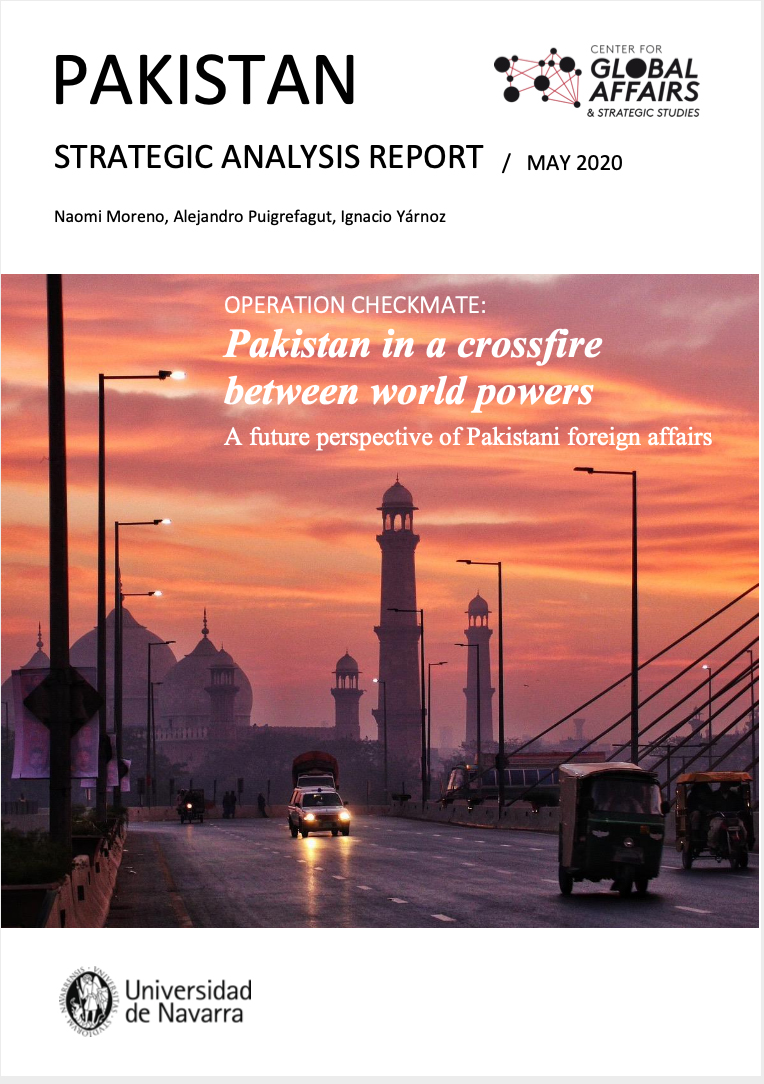 Download the document [pdf. 1,4MB] [pdf. 1,4MB
Download the document [pdf. 1,4MB] [pdf. 1,4MB
EXECUTIVE SUMMARY
This report has been aimed at examining the future prospects for Pakistan in the 2025 horizon in relation to other States and to present various scenarios through a prospective strategic analysis.
The research draws upon the fact that, despite the relatively short space of time, Pakistan is likely to undergo several important changes in its international affairs and thus feel forced to rethink its foreign policy. This strategic analysis suggests there could be considerable estrangement between the U.S. and Pakistan and, therefore, the American influence will decrease considerably. Their security alliance could terminate, and Pakistan would cease to be in U.S.' sphere of influence. Moreover, with the new BRI and CPEC projects, China could move closer to Pakistan and finally become its main partner in the region. The CPEC is going to become a vital instrument for Pakistan, so it could significantly increase Chinese influence. Yet, the whole situation risks jeopardizing Pakistan's sovereign independence.
India-Pakistan longstanding dispute over Kashmir seems to be stagnated and will possibly remain as such in the following years. India has taken steps to annex its administered territory in Jammu and Kashmir and Pakistan could potentially follow. The possibility of an open conflict and a nuclear standoff remains possible as both nuclear powers have very different strategies and conceptions which could lead to misinterpretation and a nuclear escalation.
In the quest to rethink its foreign policy, the U.S.-Taliban peace and the empowerment of the group has come as a bolt from the sky for Pakistan. Through its ties with the Taliban, Pakistan could gain itself a major presence in the region namely by reaching out to Central Asia and advance its interest to curtail India's influence. Amid a dire economic crisis, with regards to the Saudi Iranian Cold War, Pakistan could seek a way in which it can recalibrate its stance in favour of the resource-rich Saudi alliance while it appeases sectarian groups who could strongly oppose this potential policy.
Pakistan ought to acknowledge that significant changes ought to be made in both the national and international sphere and that decisive challenges lay ahead.
![A woman crosses a bridge in a rural area of Pakistan [Pixabay]. A woman crosses a bridge in a rural area of Pakistan [Pixabay].](/documents/10174/16849987/pakistan-report-blog.jpg)
▲ A woman crosses a bridge in a rural area of Pakistan [Pixabay].
STRATEGIC ANALYSIS REPORT / Naiara Goñi, Roberto Ramírez, Albert Vidal
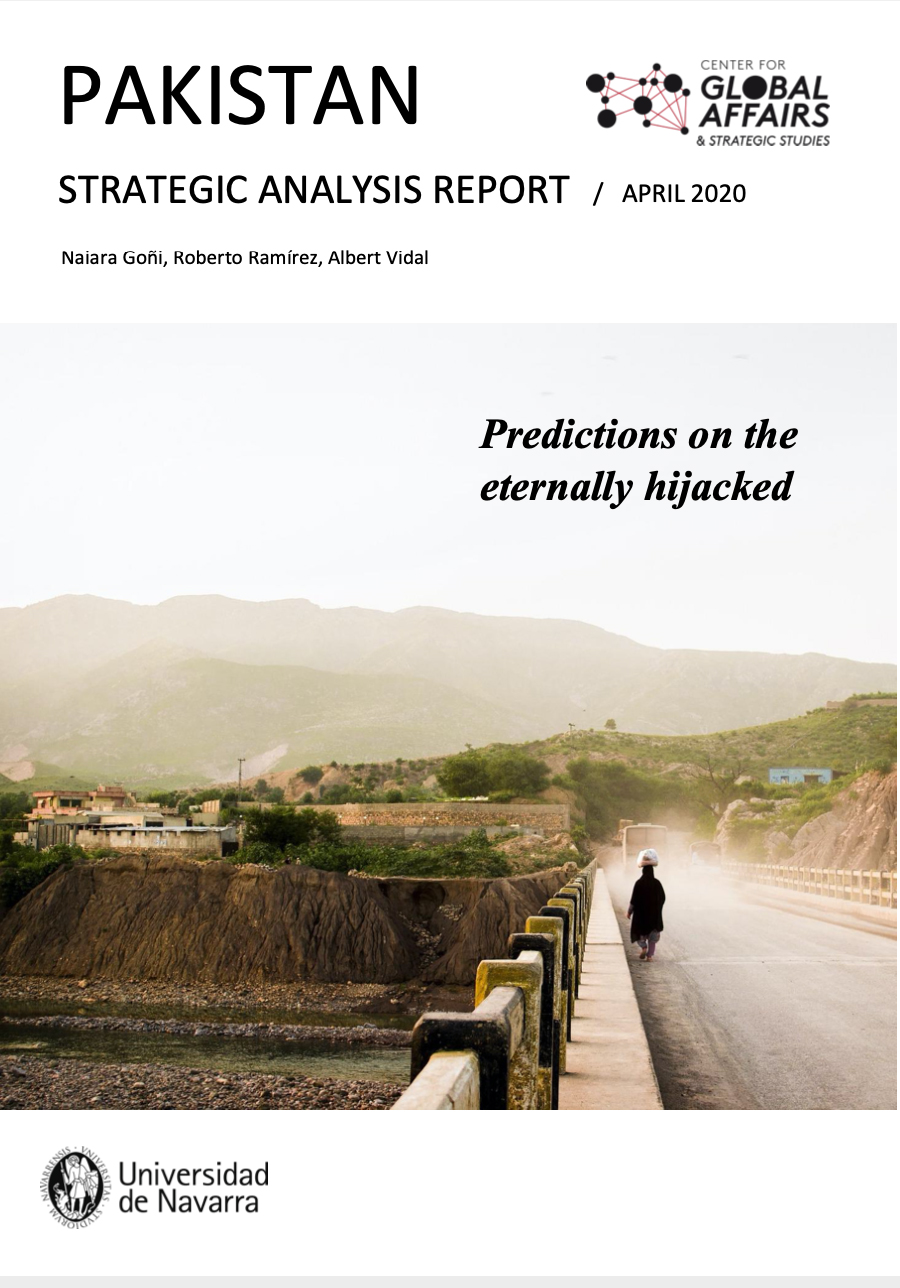 Download the document [pdf. 1,4MB] [pdf. 1,4MB
Download the document [pdf. 1,4MB] [pdf. 1,4MB
EXECUTIVE SUMMARY
The purpose of this strategic analysis report is to ascertain how geopolitical dynamics in and around Pakistan will evolve in the next few years.
Pakistani relations with the US will become increasingly transactional after the US withdrawal from Afghanistan. As the US-India partnership strengthens to face China, the US will lose interest in Pakistan and their priorities will further diverge. In response, Beijing will remain Islamabad's all-weather strategic partner despite claims that the debt-trap could become a hurdle. Trade relations with the EU will continue to expand and Brussels will not use trade leverage to obtain Human Rights concessions from Islamabad. Cooperation in other areas will stagnate, and the EU's neutrality on the Kashmir issue will remain unchanged.
In Central Asia, Islamabad will maintain positive relations with the Central Asian Republics, which will be based on increasing connectivity, trade and energy partnerships, although these may be endangered by instability in Afghanistan. Relations with Bangladesh will remain unpropitious. An American withdrawal from Afghanistan will most likely lead to an intensification of the conflict. Thanks to connections with the Taliban, Pakistan might become Afghanistan's kingmaker. Even if regional powers like Russia and China may welcome the US withdrawal, they will be negatively affected by the subsequent security vacuum. Despite Pakistani efforts to maintain good ties with both Iran and the Kingdom of Saudi Arabia (KSA), if tensions escalate Islamabad will side with Riyadh. Pakistan's weak non-proliferation credentials will be coupled with a risk of Pakistan sharing its nuclear arsenal with the Saudis.
A high degree of tensions will continue characterising its relations with India, following the abrogation of Articles 370 and 35A of the Indian constitution. Water scarcity will be another source of problems in their shared borders, which will be exacerbated by New Delhi's construction of reservoirs in its territory. Islamabad will continue calling for an internationalization of the Kashmir issue, in search of international support. They are likely to fight localised skirmishes, but there is a growing fear that the contentious issues mentioned above could eventually lead to an all-out nuclear war. PM Khan and Modi will be reluctant to establish channels of rapprochement, partly due to internal dynamics of both countries, be it Hindu nationalism or radical Islam.
A glance inside Pakistan will show how terrorism will continue to be a significant threat for Pakistan. As a result of Pakistan's lack of effective control in certain areas of its territory, the country has been used as a base of operations by terrorist and criminal groups for decades, to perpetrate all kinds of attacks and illegal activities, which will not change in the near future. Risks that should be followed closely include the power of anti-Western narratives wielded by radical Islamists, the lack of a proper educational system and an ambiguous counter-terrorism effort. In the midst of this hodgepodge, religion will continue to have a central role and will undoubtedly be used by non-state actors to justify their violent actions, although it is less likely that it will become an instrument for states to further their radical agendas.
Iran Strategic Report (July 2019)
This report will provide an in-depth analysis of Iran's role in the Middle East and its impact on the regional power balance. Studying current political and economic developments will assist in the elaboration of multiple scenarios that aim to help understand the context surrounding our subject.
J. Hodek, M. Panadero.
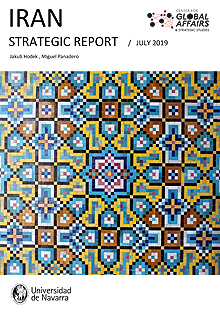 Report [pdf. 15,5MB] [pdf. 15,5MB
Report [pdf. 15,5MB] [pdf. 15,5MB
INTRODUCTION: IRAN IN THE MIDDLE EAST
This report will examine Iran's geopolitical presence and interests in the region, economic vulnerability and energy security, social and demographic aspects and internal political dynamics. These directly or indirectly affect the evolution of various international strategic issues such as the future of Iran's Nuclear Deal, United States' relations with Iran and its role in Middle East going forward. Possible power equilibrium shifts, which due to the economic and strategic importance of this particular region, possess high relevance and significant degree of impact even outside the Iranian territory with potential alteration of the regional and international order.
With the aim of presenting a more long-lasting report, several analytical techniques will be used (mainly SWOT analysis and elaboration of simple scenarios), in order to design a strategic analysis of Iran in respect to the regional power balance and the developments of the before mentioned international strategic issues. Key geopolitical data will be collected as of the announcement of the U.S. Secretary of State Michael R. Pompeo on the re-imposition of U.S. sanctions on the Islamic Republic of Iran on November 2, 2018 with a projection for the upcoming years, thus avoiding a simple narration of facts, which transpired so far.
First part of this report will be dedicated to a more general analysis of the geopolitical situation in the Middle East, with a closer attention to Iran's interests and influence. Then, after a closer look on the internal dynamics within Iran, several scenarios will be offered out of which some will be categorized and selected as the most probable according to the authors of this report.
Iran Country Risk Report (June 2019)
After some months of implementation, the re-imposed US sanctions against Iran are seriously affecting Iranian economy and forcing disputed political and even military reactions. The present report attempts to provide an analysis of Iran by addressing: the consequences of sanctions, the current and future state of its energy sector, the internal situation of the country, and the future prospect of the Iran-US relations.
C. Asiáin, M. Morrás, I. Urbasos
 Report [pdf. 14,1MB] [pdf. 14,1MB
Report [pdf. 14,1MB] [pdf. 14,1MB
EXECUTIVE SUMMARY
The US unilateral withdrawal from the JCPOA on May 8, 2018, reshaped the Iranian domestic and international reality. On the one hand, the JCPOA enabled Iran to increase its GDP above 7% in the period of 2016-2018, more than double its oil exports and maintained President Rouhani in office after the 2017 elections. On the other hand, the US reimposition of the previously lifted sanctions demonstrated the deep vulnerabilities of the Iranian economy and its huge diplomatic isolation.
US sanctions will affect the whole of Iran's foreign relations due to its extraterritorial nature. The EU will try to avoid its effect through legal protection of its companies and citizens with mechanisms such as the SPV, whose scope and effectivity is yet to be proved. China, as it is less exposed to the US financial and political influence, will be able to better circumvent sanctions but still far from being totally unaffected. Other countries such as India, Turkey or Russia will find difficulties to handle secondary sanctions, but will be able to maintain a certain degree of trade with the Islamic Republic. Japan or South Korea will have to follow US demands because of its strategic alliance in the Asia-Pacific region and resume energy imports and investments.
The Iranian economy is expected to enter into recession during 2019, GDP growth is expected to be -4.5% and unemployment rate will increase to the 15.4%. This economic hardship will concentrate the political discussion in the 2020 legislative and 2021 presidential elections, whose outcome will determine if a moderate or hardliner political faction seizes power. Social unrest from ethnic minorities and opposition is expected to rise if the economic conditions do not improve, challenging the current political equilibrium of the country.
The energy sector will be deeply affected by US sanctions as it banned all countries from investing and purchasing Iran's energy products. Sanctions are expected to reduce Iran oil exports to 1million barrels a day from the 2017 levels of 2.4 mbdp, decreasing governmental revenues drastically and freezing most foreign investments. The lack of FDI and technology will aggravate the problems of the Iranian energy sector with possible irreversible effects depending on the sanctions duration.
US-Iran relations are expected to worsen at least until the US 2020 Presidential elections, when a more dialoguing candidate could substitute the hawkish Trump administration. The United States is expected to maintain its current strategic alliances with Saudi Arabia and Israel, whose common goal of pressuring Iran can have unexpected consequences for the Middle East. Domestic politics in Iran, US, Israel and Saudi Arabia will play a major role in the evolution of the events.
Iran Country Risk Report (May 2019)
The sanctions that the United States is implementing against the Islamic Republic of Iran since November 2018 are the toughest sanctions ever imposed on Iran. They threaten to cut off foreign countries and companies dealing with Iran from the US financial system in order to deter business with Iran so to curtail the impact of proxy groups on the Middle East's security and stability. The aim of this country report is to provide the most recent analysis of the Iran's economic and political situation, and estimate its evolution in the short and medium term. It presents an overlook of specific clues about matters related to political risk, as well as the effect that sanctions may have on the Iranian economy, and the prospects for political stability all over the region.
Alona Sainetska
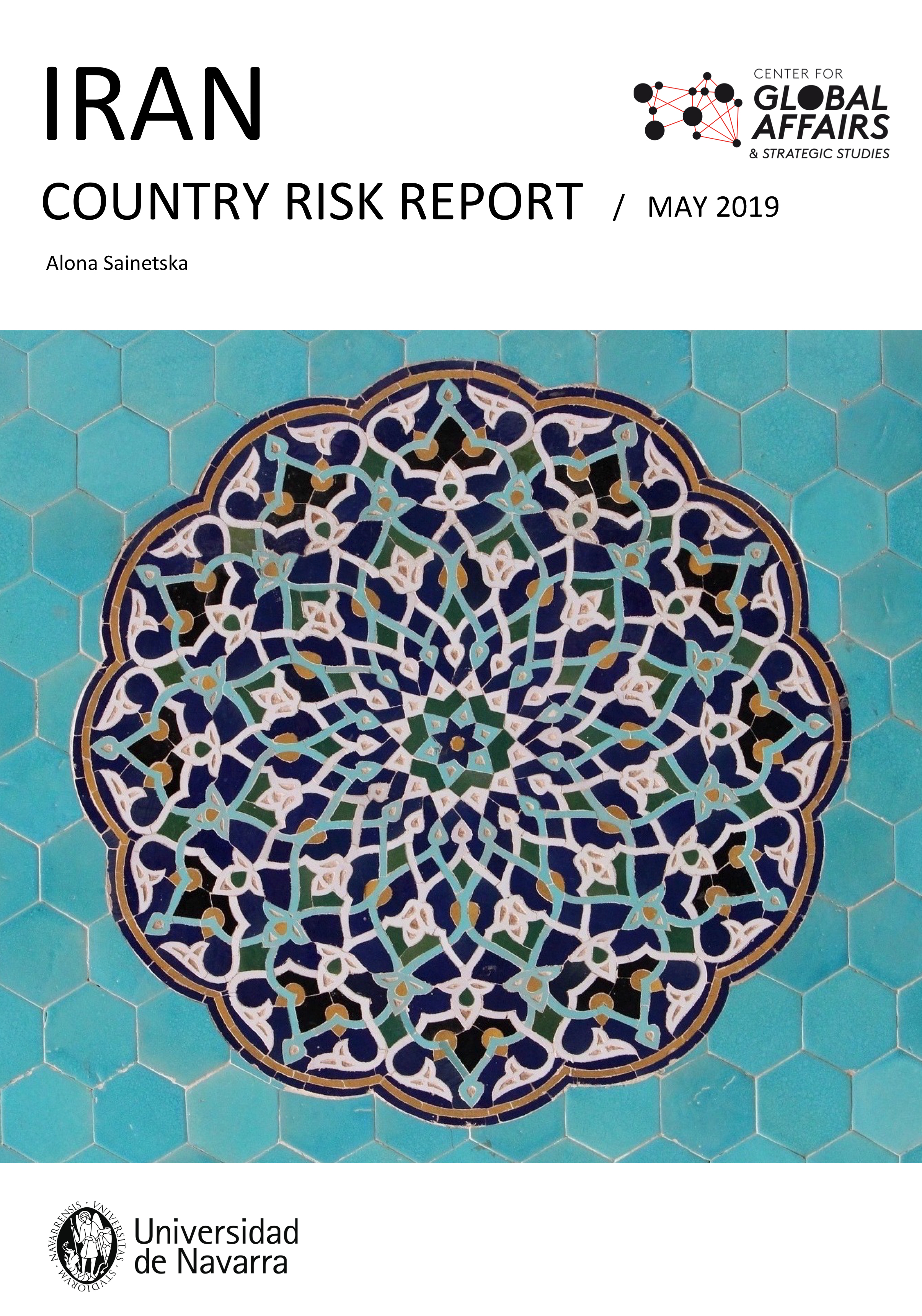 Report [pdf. 13,5MB] [pdf. 13,5MB
Report [pdf. 13,5MB] [pdf. 13,5MB
EXECUTIVE SUMMARY
Effects of sanctions
The re-imposition of US sanctions will maintain the Iranian economy in recession during the remaining months of 2019. Notwithstanding the foregoing, the economic meltdown will be very unlikely to happen, as the volume of oil exports is still significant, crude prices are going to continue to rise and other major powers' opinion will still differ from the US's. The multinational companies dependent on US financial system will continue leaving the Iranian market, partially leading to declining of the foreign investment, but SMEs will be almost unaffected and new forms of trading are likely to emerge soon.
Iran is likely to build stronger economic and political ties with India, China and Russia, thus giving them more power and openness to new trading opportunities, basically due to lack of any other possible partner on the horizon in the mid-term.
The prices are likely to keep growing up in the following months reaching the average inflation of 31.2% in 2019-20; still the risk of hyperinflation is discarded due to the fact that Iran is able to meet a significant share of local demand through local production.
Backed by support from the EU, Iran is promised to obtain in the mid-term a special mechanism of payments (Special Purpose Vehicle) for its oil and other exports (possibly through a barter system) in order to conduct trading outside of the competence of the US sanctions. This is likely to create some tensions between Europe and the US but they will not be powerful enough to split the long-lasting alliance between the two.
Oil and gas
The Iran's production of oil will probably continue to decrease affecting the world's oil price.
Five from the eight initial major buyers (Italy, Greece and Taiwan have already stopped their purchases from Iran) are and will be buying Iranian oil now that the waivers have been extended for the following 90 days. Thereby, the Iranian oil will still remain in demand during the following years, and Iran's government is likely to find solutions for its selling and exportation, even though illegally, in the mid and long-term. Thus, the United States is unlikely to meet its earlier target of driving Iranian oil exports to zero.
Iraq will continue to buy natural gas from Iran in order to use it in the production of electricity, becoming the second largest customer. Taking into account the fact that there is a sort of competence between US and Iran for the influence over Iraq, it can fuel a further deterioration of their relations. It is also plausible that more buyers will emerge if some new forms of trading, which do not rely on dollar, appear soon.
Even though the modest production growth is likely to continue, Iran won't be able to unilaterally monetise its natural gas resources due to lack of financial partners and investment, especially from the West. However, it will be able to fulfil its domestic demand and sustain trade with Turkey.
Iran's ability to increase production and exports of natural gas will be almost improbable, unless the relations with the United States are improved or support from international partners in defiance of sanctions is reinforced. Nevertheless, if Iran manages to accomplish current development projects, its export pipeline capacity will increase from 46.4 bcm/year in 2018, to 119.7 bcm/year to the regional and global markets in a long run. China, India and Pakistan will play a significant role in Iran's natural gas sector.
The domestic scene
Iran will continue demonstrating considerable resilience in coping with US sanctions, and is likely to continue to fully implement the commitments of JCPOA as long as China, Russia, or countries which are non-members of the deal, such as India, continue to trade with it, and if EU continues maintaining its constructive attitude. In this case, even a greater international support and United Nations diplomatic intervention is expected in the mid-term. However, on a longer run, the JCPOA future will depend upon the economic situation and complex political battles between moderates and hardliners in Tehran.
The current deterioration of the economic conditions in Iran, the rial devaluation and growing inflation, together with already-high unemployment will provoke a further popular discontent which is likely to maintain the protests but without any considerable probability to threaten the Iranian political stability or lead to leadership's rupture during the upcoming years.
The sanctions are likely to produce some adverse effects on the local political scene over the longer term, as Iranian hardliners may take advantage of them and the popular frustration and obtain the victory in the coming 2020 parliamentary elections and the 2021 presidential poll. As a result, any possibility for future cooperation with US will equal zero.
AMERICAN REGIONAL SECURITY, report 2019
The report American Regional Security (ARS) that we are launching has the purpose to address annually the most recent threats to the security of American countries. It deals with a space that is largely the security region of the United States, so that many aspects transcend the national sphere and become a geopolitical consideration. The security of the Western Hemisphere is therefore also the concern of the European Union or Spain, which have an interest in stability and prosperity on the other side of the Atlantic. Our SRA is a radar-like sweep of the most significant issues that have occurred in this field over the past year.
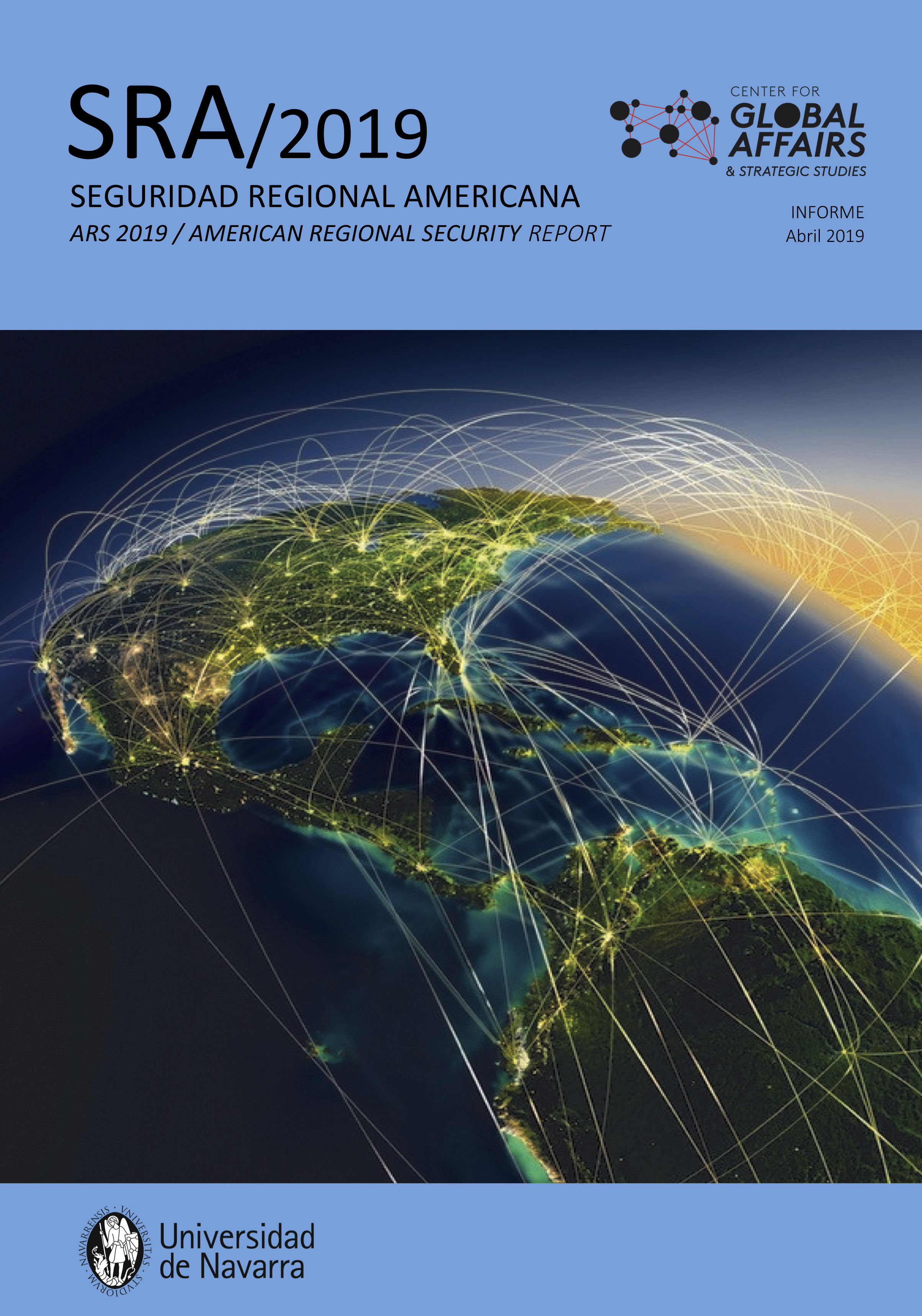 Open the full PDF of the report [pdf. 19,7MB] [pdf. 19,7MB
Open the full PDF of the report [pdf. 19,7MB] [pdf. 19,7MB
summary EXECUTIVE[PDF version].
The present global geopolitical tension is being played out in the near abroad of the three major powers. This term applies specifically to the space that was once part of the USSR and now surrounds Russia: the Kremlin's foreign policy is aimed both at securing its influence in these areas and preventing some of them from becoming the pawns of others. But such a struggle, like the one occurring in Ukraine or the Baltic republics, is also taking place in China's near abroad: the East and South China Seas. And similarly, albeit with less drama, the geopolitical game has also reached that near abroad of the United States, which goes beyond the backyard of the Greater Caribbean and could extend at least as far as the Equator.
Over the past year the security region of states has fully entered this new phase of acute geopolitics. This is due in particular to Russia's increased presence in the region, especially in Venezuela, where economic aid has in recent months given way to a succession of military gestures that defy the US. Furthermore, the agreement signed by Cuba to install a Glonass station, the Russian satellite navigator, raises the possibility that Moscow may once again want to use the island for intelligence work, as in the Cold War. Similar suspicions exist regarding a station already opened in Managua, where a Russian-run police academy has also been viewed with suspicion by the Pentagon.
|
Donald Trump and Vladimir Putin, July 2018 [Shealah Craighead]. |
Alongside such Russian activity in the region, Washington sometimes places China's activity in the region. While not seeking to anger the US, as can be attributed to the Kremlin's desire to reciprocate the pressure it has received in Ukraine, Beijing's commercial moves are perceived by the Americans as unfriendly. This is especially true in Central America, where in a few years China has been displacing the peculiar influence of Taiwan, which in 2018 lost the support of El Salvador and the Dominican Republic. Throughout the year, various US authorities expressed discomfort with China's position-taking in the Panama Canal area. Moreover, after a 2016 with hardly any loans to Venezuela and a blank 2017, Beijing granted in 2018 a 5 billion dollar loan to the Chavista regime (now 67.2 billion dollars).
The Venezuelan crisis is not only generating friction between the three main powers, but is also a source of insecurity for the surrounding countries. The space that Maduro's government has continued to give to Colombian guerrillas has contributed to the fact that 2018 can be considered the year of consolidation of the criminal activity of FARC dissidents, at partnership with the ELN, a guerrilla group that is still active as such and is also increasing its radius of action in Venezuela. The last year also saw a strengthening of the ELN, which, following the failure of its negotiations with the government, carried out an attack in Bogotá in January 2019, causing 21 deaths. FARC dissidents numbered around 2,000 at the end of 2018, including demobilised elements returning to arms as well as new recruits. Their coca production activity, concentrated in southwestern Colombia, spilled over into violence across the border with Ecuador in 2018, in part because of the activity of "el Guacho", a former FARC member eventually killed by Colombian security forces.
The worsening of the Venezuelan status , on the other hand, has reduced surveillance at sea, increased corruption of maritime authorities and coastal municipalities, and pushed the inhabitants of these localities to seek livelihoods. As a result, episodes of piracy off the coasts of Venezuela and its eastern neighbours have increased markedly. In a single attack in April 2018 in Surinamese waters, fifteen Guyanese fishermen were killed, while the authorities of Trinidad and Tobago decided to create an elite air unit to combat these actions.
It is not the only special alert in Trinidad and Tobago. The outflow of ISIS jihadists that is resulting from the pacification of Syria has put both Washington and Port of Spain on guard against the possible return to the Caribbean country of those who went to fight in the Middle East. Trinidad and Tobago was the nation that sent proportionally the most fighters to Syria: a total of 130, out of a population that may reach two million, of whom barely five per cent are Muslim. Authorities arrested four suspected jihadists in February 2018 for planning an attack on the capital's carnival. Urged by the US, which fears the spread of Trinidadian extremists in the region, the island government developed a new counter-terrorism strategy in 2018.
International success in ending the ISIS 'caliphate' thus shifts the risk to other parts of the world. The Trump Administration's pressure on Iran may also be encouraging greater Hizbollah activity in certain enclaves of South America - such as the TBA - to compensate for the reduction in funding that could result from the effectiveness of US sanctions on Tehran. In any case, 2018 saw a revival of the White House's interest in disrupting the drug trafficking, money laundering and smuggling networks carried out by Hezbollah operatives in Latin America: the Justice department reconstituted a specific research unit and the State department labelled group, already classified by the US as a terrorist organisation, as a transnational criminal organisation. Last year also saw a leap in the cooperation of the three TBA countries - Argentina, Brazil and Paraguay - which led to the arrest of Assad Ahmad Barakat, a major Hizbollah financial operator, and some 15 members of his clan.
While migration issues are constantly topical in the Americas, 2018 can be described as "the year of the caravans", due to the various marches that left Honduras for the US border and which met with a harsh response from the Trump Administration. One of the controversial aspects was the denunciation of the possible use of these marches by alleged Islamic extremists in order to reach the US unnoticed. What is certain is that Washington has been paying attention to the Central American route of people from other continents.
Thus, in 2018 it agreed to help Panama increase control of the Darién crossing, a jungle region on the border with Colombia where almost 9,000 migrants were located that year, 91% of them Africans and Asians. Of these, 2,100 entered the US grade as 'persons of concern' (from Bangladesh, Eritrea, Pakistan, Yemen and Somalia, among other countries).
The region has also seen some progress, such as halting the rise in opioid overdose deaths in the United States, an epidemic that set a record high in 2017. Throughout 2018, the eradication of poppy crops in Mexico, whose B increase in heroin production had pushed up consumption in the US (mixed with the synthetic fentanyl, mostly also coming through Mexico), and greater legislative and sanitary control by the US authorities, seem to show signs that the problem has stopped growing.
REPORT / Jokin de Carlos Sola
Simplicity is the best word to describe this Baltic country. Its flag represents the main landscape of the country; a white land covered in snow, a black forest, and a blue light sky. And so is its economy, politics and taxation. What a minimalistic artwork is Estonia.
Estonia is the smallest of the three Baltic countries, with the smallest population and a quite big border with Russia, concretely 294 km long. Even so, Estonia has a bigger GDP per capita (17,727.5 USD in 2016 according to World Bank) than the other two Baltic states: Latvia and Lithuania. It has a bigger presence in the markets and a bigger quality of life according to the OECD in a study done it in 2017.
Technology is a very important part of Estonia's economy. According to the World Bank, 15% of Estonia's GDP are high tech industries. Following the example of Finland, Estonia has made technology the most important aspect of their economy and society. But not just that, with the eyes faced towards the future, or as the Estonians call it "Tulevik", this former part of the Soviet Union of 1,3 million inhabitants has become the most modernized state in Europe.
The 24th of February of 2018 Estonia celebrated the 100th anniversary of the its independence, so it is interesting to see how the evolution of this small country is and will continue to be.
All this has been possible because of different figures like Laar, Ilves, Ansip, and Kotka.
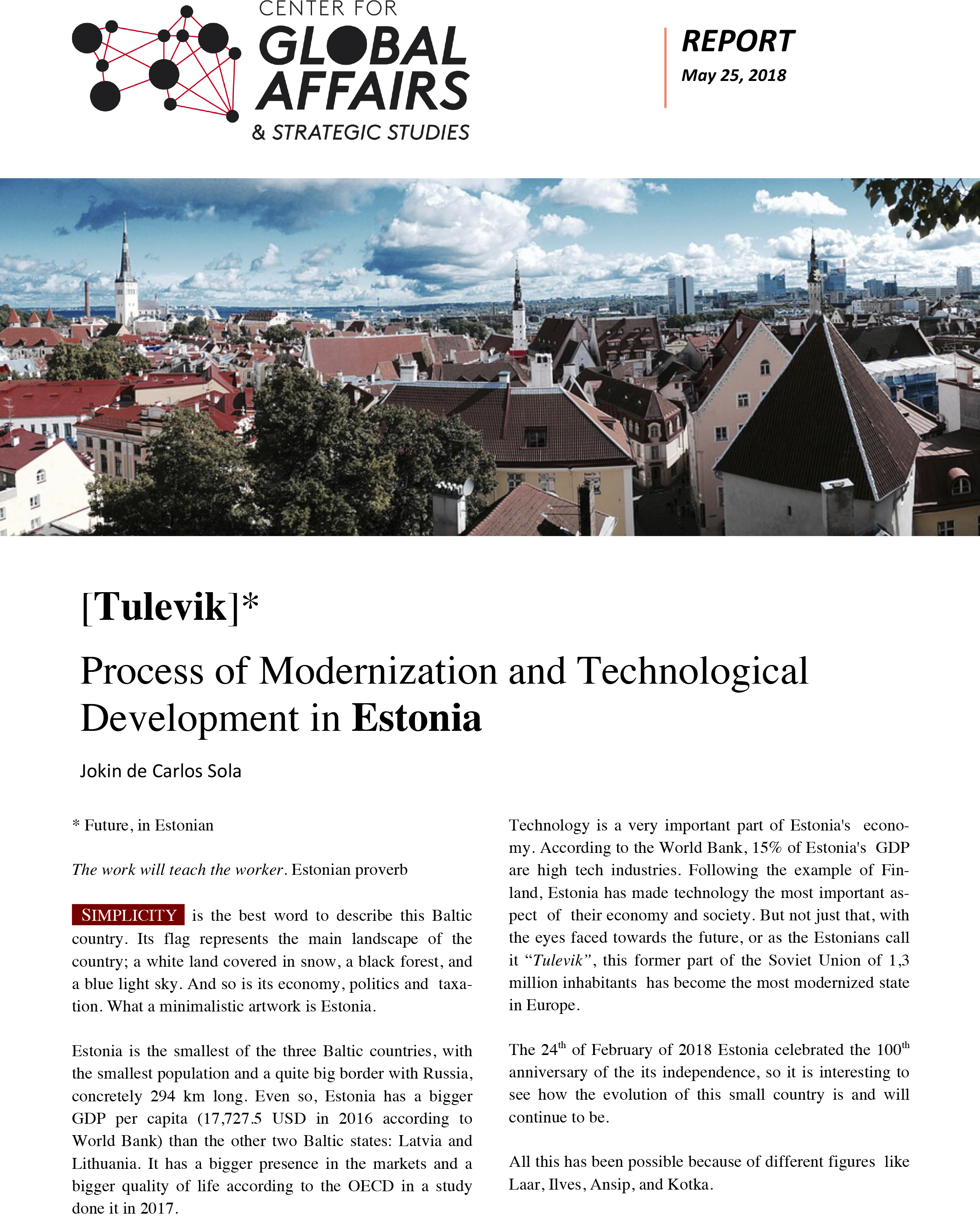 download the complete report [pdf. 3,4MB] [pdf. 3,4MB
download the complete report [pdf. 3,4MB] [pdf. 3,4MB
Showing the range 11 - 17 of 17 results.

![Donald Trump and Vladimir Putin, July 2018 [Shealah Craighead]. Donald Trump and Vladimir Putin, July 2018 [Shealah Craighead].](/documents/10174/16849987/informe-sra-blog.jpg)